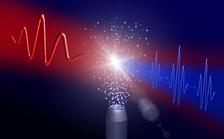By interaction with a noble gas, extremely shortwaved XUV light is produced from light of an infrared laser (Illustration: Helmholtz Institute Jena).
A team of researchers from the Helmholtz Institute Jena and DESY has paved the way for using conventional lasers to observe chemical bonds being broken apart. For their experiments, the scientists combined high-performance light generation and detection components from the two Helmholtz institutions. The resulting set-up forms the basis for observing high-speed processes with a resolution of 30 billionths of a second (30 femtoseconds). In addition, the set-up is so compact and robust that it could serve as a prototype for measuring equipment that could be installed and operated even at smaller facilities and universities.
What happens when a chemical bond is broken? How do individual atoms join to form a molecule, and disengage from each other again? Understanding the dynamics of chemical processes is often described as the “Holy Grail” of physical chemistry; once you understand what is happening, you are in a position to influence such bonds and perhaps even design completely new materials.
Observing such chemical processes with great precision calls for high-speed cameras with an extremely high temporal and spatial resolution, such as the X-ray free electron laser European XFEL, which is currently being constructed in the Hamburg metropolitan region and will allow scientists to look at individual molecules and atoms. However, a laser that emits short-wave ultraviolet light is all that is needed to observe chemical bonds being broken in small molecules – that and a coincidence detector of the type developed for synchrotron and X-ray laser experiments.
In their experiments, the Helmholtz scientists fired short pulses of high-intensity XUV light at iodomethane molecules (CH3I), also called methyl iodide, consisting of an iodine atom and a methyl group (CH3). The light broke the bond between the iodine and the methyl group, and the fragments of the molecule were captured and measured in a spectrometer. This allowed the rearrangement of the electrons in the excited molecule to be deduced, and hence the subsequent induced chemical processes.
The experiments were based on a tabletop laser system for light in the so-called extreme ultraviolet range (XUV). The laser, which was developed at the Helmholtz Institute Jena, produces very short, high-intensity pulses of XUV by first strongly amplifying a pulse of infrared radiation in an optical fibre, and subsequently generating odd multiples of the original laser frequency. For these experiments, one of these so-called higher harmonic frequencies, with a wavelength of about 18 nanometres, was extracted using special optical devices and used for the experiment.
“The XUV laser system produces flashes of light consisting of one million photons, which only last 30 femtoseconds, with a pulse frequency of up to 100 kilohertz,” explains Professor Jens Limpert. Jan Rothhardt, who helped to develop the laser, adds: “The combination of a high photon flux and very high repetition rate in combination with very high stability qualifies this system, in principle, to carry out user experiments in chemical dynamics.”
Using higher harmonics to produce the pulses offers an additional built-in advantage: a chemical reaction can be triggered by a pulse of light produced by the laser, and then examined after a fixed time using a pulse of XUV radiation produced by the same laser. “The delay between the first and the second pulse can be adjusted with a high degree of precision,” says Rothhardt. This “pump and probe” technique was not yet used in the first series of experiments; but it has already been tested and is to be included in follow-up experiments.
A second important component of the experiments was a complex sample and detector chamber, developed for use in free electron lasers (FELs), which had already been deployed in DESY’s FLASH and PETRA III accelerators. In this CAMP experimental chamber, operated by Daniel Rolles´ group at that time, the sample was fired into the beam of light as a thin jet travelling at supersonic speeds. The interaction with the XUV radiation destroyed the molecules, and the properties of the fragments that fly away were measured with great precision in a built-in spectrometer. Coincidence measurements allowed the captured fragments to be assigned to their original molecules, and the precise characterisation of the building blocks means that the breaking of the bond can be deciphered across time.
“By bringing together the experimental and scientific possibilities from Jena and Hamburg, we are opening up new opportunities for observing chemical dynamics,” says DESY scientist Professor Jochen Küpper, who instigated the experiments and who is also a member of the Center for Free-Electron Laser Science and the Hamburg Centre for Ultrafast Imaging at the University of Hamburg. DESY scientist Tim Laarmann adds: “In the next step, we will use the apparatus to conduct pump and probe experiments. In principle, this set-up should in fact allow us to achieve much higher temporal resolutions of less than one femtosecond, making it possible to observe extremely fast movements of electrons in complex molecules.”
(from DESY News)
Spotlight article of the journal







